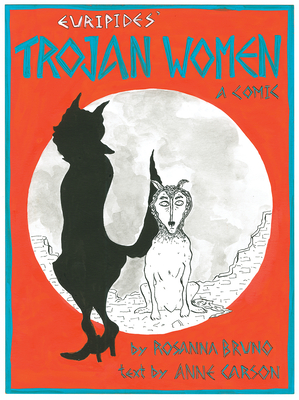
The Trojan Women: A Comic
Description
A fantastic comic-book collaboration between the artist Rosanna Bruno and the poet Anne Carson, based on Euripides’s famous tragedy
A NEW YORK TIMES BEST GRAPHIC NOVEL OF 2021
Here is a new comic-book version of Euripides’s classic The Trojan Women, which follows the fates of Hekabe, Andromache, and Kassandra after Troy has been sacked and all its men killed. This collaboration between the visual artist Rosanna Bruno and the poet and classicist Anne Carson attempts to give a genuine representation of how human beings are affected by warfare. Therefore, all the characters take the form of animals (except Kassandra, whose mind is in another world).
Praise for The Trojan Women: A Comic
A loose, peculiar and deeply affecting adaptation of the antiwar tragedy by Euripides.
— Hillary Chute - The New York Times Best Graphic Novels of 2021
Rosanna Bruno’s Slanted Life is so hysterical, you may find yourself with a case of the vapors.
— Alison Bechdel, author of Fun House
Bruno’s monochromatic drawings depict characters as animals and everyday objects, accompanied by a weary chorus of dogs and cows. This gives phantasmagoric shape to Carson’s characteristically uncategorizable translation. Carson preserves some of the ancient Greek text’s inscrutability, but also imbues it with contemporary immediacy: Poseidon enters making allusions to James Baldwin, and Hekabe, brooding about the role of Helen in the city’s downfall, calls her the 'why and fucking wherefore of it all.'
— New Yorker
Set in post-war Troy, this wrenching comics-poetry update of Euripides’ tragic play by poet Carson and artist Bruno embodies feminine narratives with wry lyricism. Bruno’s black-and-white illustrations literalize poetic metaphors to whimsical effect. Yet the cleverness and agility of this graphic work amplify its tragedies.... Even the infamous Helen, a shape-shifter who appears as a silver fox and a mirror, must defend her life to her husband, the king Menelaos, after Hekabe wants her 'sentenced to death out of her own mouth' for her apparent complicity in the downfall of Troy.... Accompanied by a chorus of cows and dogs, Hekabe mourns the death of a final heir (drawn as a sapling) and says, 'We can’t go on/ we go on.' Such is the story of war and genocide throughout history, and in Carson and Bruno’s expert hands, it strikes as powerfully contemporary.
— Publishers Weekly (starred)
In her classical translations, Carson has pursued what T. S. Eliot called "acontinuous parallel between contemporaneity and antiquity."
— Will Harrison - BOMB
What do you get when you cross Euripides’ classic tragedy, the artistic stylings of Rosanna Bruno, and the poetic touch of Anne Carson? This book! Here’s what we know: Troy has been ravaged. Everyone is depicted as an animal (except Kassandra, who is another planet, which actually makes complete sense when you think about it). Need I say more?
— Lithub
Anne Carson is a daring, learned, unsettling writer.
— Susan Sontag
Bruno’s illustration works wonderfully with Carson’s text, making [for] a beautiful, affecting translation.
— Women’s Review of Books
Carson and Bruno have risen to an unusual challenge. Their medium’s conventions could have flattened distinctive literary qualities, but their book instead refocuses our attention on Euripides’ styles. The format highlights this play’s outstanding quality, praised by Sidney as ‘sweet violence’. That phrase was borrowed by Terry Eagleton to entitle his own book on the tragic (2002), in which he said that tragedy can only survive as a twenty-first-century art form if it is metaphysically open, aesthetically beautiful and unflinching in its depiction of suffering. All three criteria are fulfilled by this innovative version of Trojan Women.
— Edith Hall - Times Literary Supplement
Even at its best, the poetic mainstream we call the lyric tradition can run the risk of appearing po-faced. So it’s a joy to come across a mistress of the art taking rumbustious pleasure in revisiting the matter of poetry itself. Anne Carson’s new version of Euripides’ The Trojan Women, with artist and cartoonist Rosanna Bruno, is resolutely subtitled A Comic; and a graphic novel is exactly what it is. But of course the words are Carson’s—simultaneously straight-talking and experimental.
— Fiona Sampson - The Guardian
In their new collaborative comic-book adaptation of Euripides’ The Trojan Women, poet and classicist Anne Carson and artist Rosanna Bruno lean into the irrationality, the volatility of translation. Bizarre, haunting, and hallucinatory illustrations by Bruno render the tragedy’s characters as animals (dogs, cats, crows, cows) and inanimate objects (a cracked poplar tree, “some sort of gearbox, clutch or coupling mechanism”). What results is a gnarly, perfectly inscrutable dreamscape of Euripides’ tragedy.
— Lily Houston Smith - Vol. 1 Brooklyn
Anne Carson teamed up with Rosanna Bruno for this irreverent rendering of Euripides's tragedy following the fates of the titular women — here represented as animals — in the wake of the sack of Troy.
— Globe and Mail
A great tragedy as well as an odd and terrific piece of work. Instead of actors on a stage, we have Bruno’s dogs and cows (the captive Trojan women), a surging sea (Poseidon), a pair of overalls (Athena), a poplar and sapling (Hektor’s wife Andromache and their son Astyanax), Helen alternately as a silver fox and a hand mirror, and Menelaos as “some sort of gearbox clutch or coupling mechanism.” I wouldn’t have believed these images would work if I hadn’t seen them interacting with Carson’s swift, bold communication of Euripides’s words and spirit. For me, Bruno’s strange, crude, and somehow completely evocative images do what acting can’t.
— Bob Blaisdell - Los Angeles Review of Books
By abandoning Euripides’ original words and syntax, and indeed the task of literary translation itself, Carson lays bare the central emotion of the women in the play and forces us to feel in our very nerve endings what it is like to be abandoned.
— Signorelli-Pappas - World Literature Today
